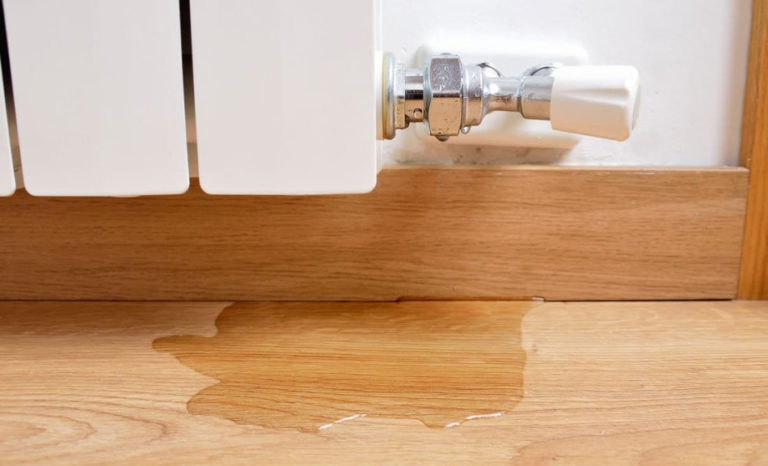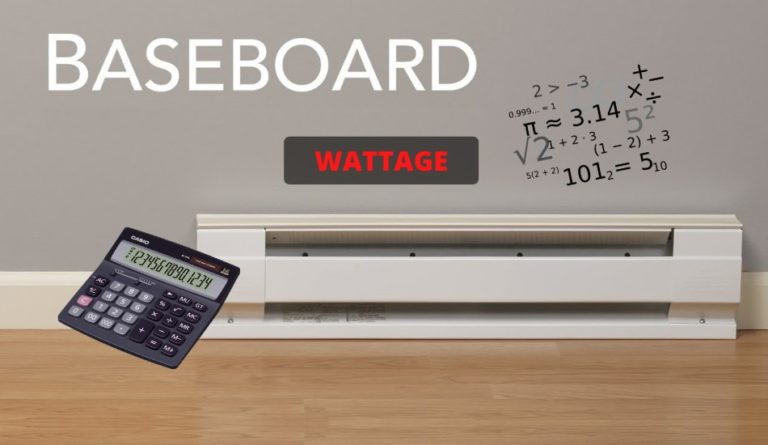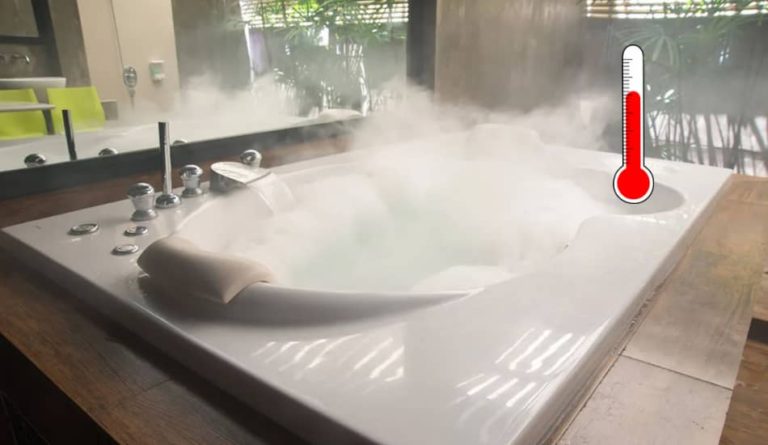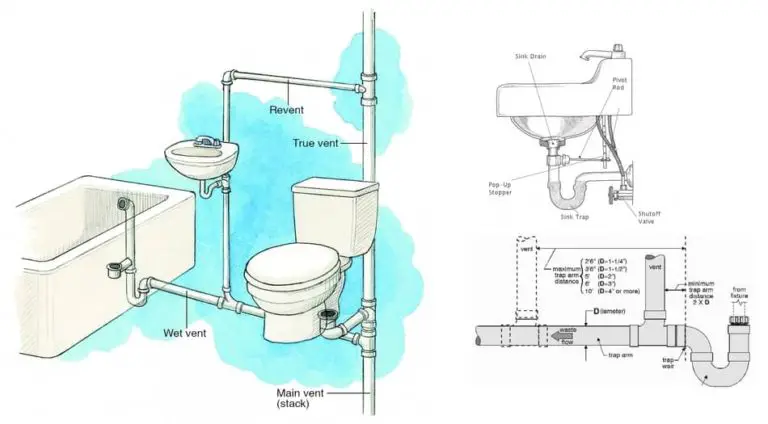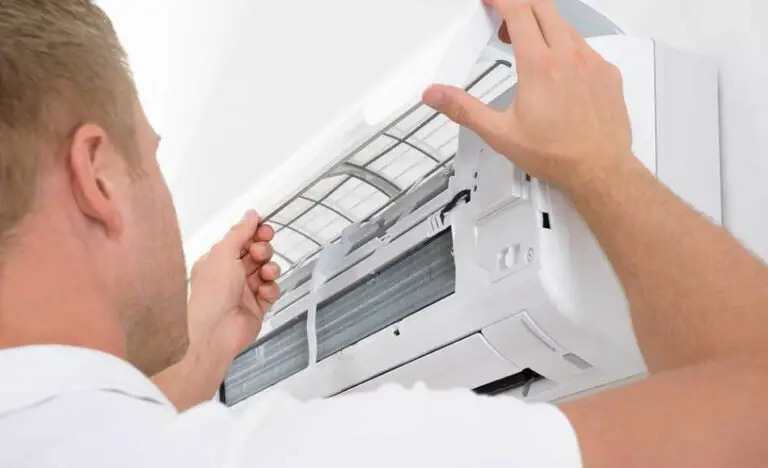15 Parts of a Kitchen Sink (with a 3D Diagram)
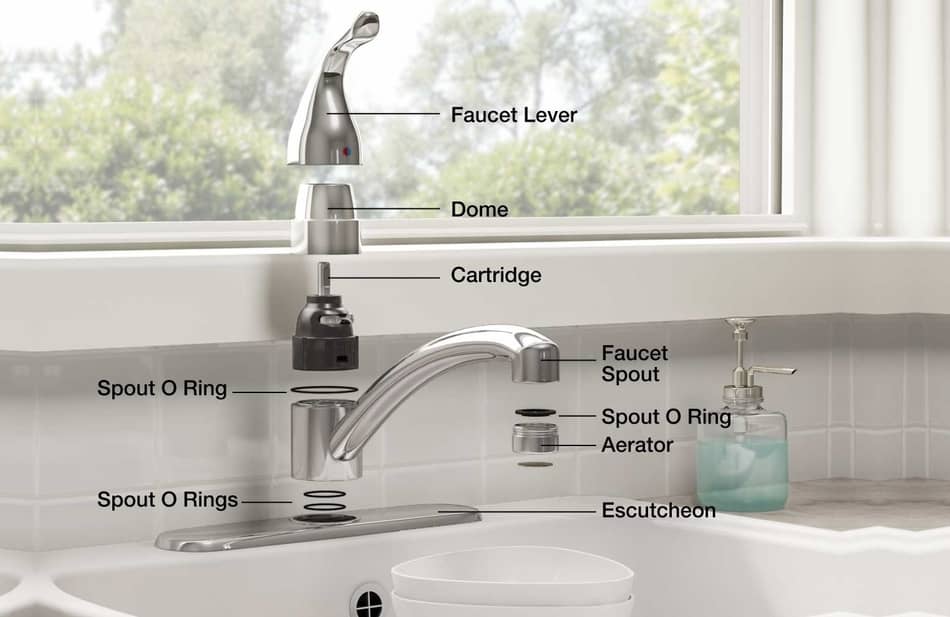
The kitchen sink is part of the household infrastructure without which life today is almost unthinkable. It is used as a water source for washing dirty dishes, hands, and wastewater disposal. They can be found on the market in various forms and they are made of different materials. Also, kitchen sinks are a bit harder to install than a bathroom sink, but for those who are skilled in DIY projects, installing a kitchen sink should not be a problem.
To install a kitchen sink it is necessary to have some knowledge of plumbing and to know the basic parts of the sink. Knowing which parts the kitchen sink contains and the ones in the bathroom is always helpful.
The main parts of the sink are: drain, faucet, basin, and controls. Also, there are other parts that the sink without it can properly function such as: P-trap, water supply pipes, and tailpiece. By cleaning the sink, the clogs that cause blocking are removed, and with the help of the shut-off valve, the flow of water into the sink is controlled.
Also if you want to learn more, be sure to read Kitchen Plumbing Systems | Diagrams & Types.
Table of Contents
Kitchen Sink Parts
Below we bring you an overview of kitchen sink parts along with illustrations to help you learn what a kitchen sink consists of. Here are the 15 main kitchen sink parts:
| Main Kitchen Sink Parts | Role of Kitchen Sink Parts |
| 1. Basin | Retains water that is placed in the faucet before it goes through the drain. |
| 2. Faucet | It is part of the kitchen sink that distributes water into the basin. |
| 3. Faucet Aerator | It is a screen that is located at the top of the faucet. |
| 4. Compression Coupling | They are responsible for the connection of two pipes or joining a valve to a pipe. |
| 5. Sprayer Hose | Additional equipment that is used for manual dishwashing. |
| 6. Countertop | This is a flat surface working area that is located around the sink. |
| 7. Garbage Disposer | A device that is used to grind up and wash away food residues and waste products. |
| 8. P Trap | It prevents water from spilling out of the pipe and stops sewer gas from coming up. |
| 9. Tailpiece | Allows water to go directly to the plumbing system. |
| 10. Waste Arm | Is pipe that carries out the wastewater into the sewer. |
| 11. Cold & Hot Water Pipes | Are used to connect the cold and hot water to the faucet. |
| 12. Rubber Gasket | It is a protective barrier that is placed between joints. |
| 13. Basket Strainer | Is used to allow water to flow down the drain and to blocks debris. |
| 14. Drain Pipe | Is used to transport dirty water that is placed in the sink out of your home. |
| 15. Shutoff Valve | This valve is used to stop the water flow. |
1. Basin
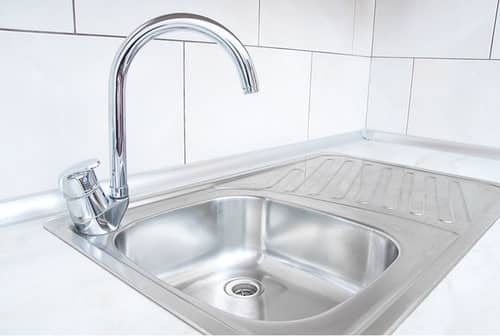
The kitchen basin is the upper part of the sink in which the water that comes out from the faucet is retained before it ends up in the drain. This is the most important part of any kitchen sink that is used for various purposes like washing dishes or washing hands. The basin can be installed directly on the wall, on a pedestal, or on a kitchen worktop.
The kitchen basin can be found in different shapes and sizes. Also, the basins can be made of porcelain, stainless steel, and iron. Each of them has its disadvantages and advantages, so the homeowner must decide for himself which material suits him best.
2. Faucet
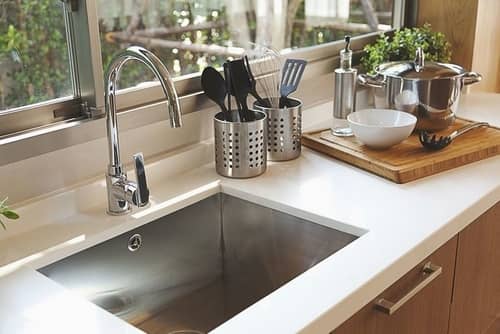
The main task of the faucet is to bring water into the sink thus making it also one of the main parts of the sink. Like basins, faucets can be found on store shelves in different shapes and they can also be made of different materials. But they all have the same task – to drain the water into the basin. Faucets are divided into single and double. The single ones have only one handle that controls the inflow of hot and cold water, and the double ones have cold and hot water in the pool by running two separate handles.
3. Faucet Aerator
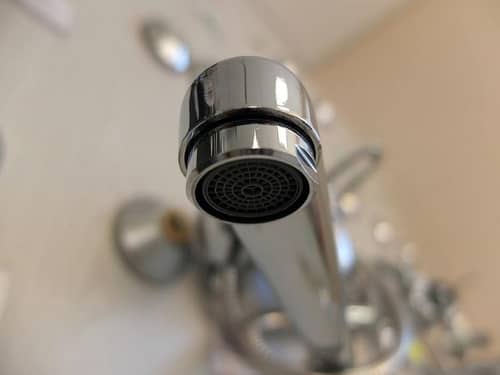
The Faucet aerator is a small net that is attached to the very top of the faucet. The main function of the faucet aerator is to control and regulate the amount of water that is coming out of the faucet through small net openings. It splits the water into small streams. That way it reduces the water volume that is coming from the faucet.
Related Article: How to Fix the Leak Under Bathroom Floor?
4. Compression Coupling
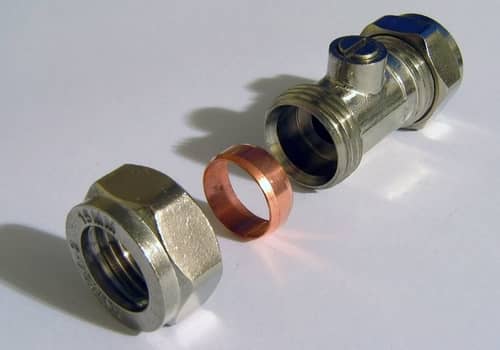
Couplings (also known as compression fittings), as the name suggests, have the function of connecting a valve to a pipe or connecting two pipes. When it comes to kitchen sink coupling, it connects water pipes and faucets.
5. Sprayer Hose
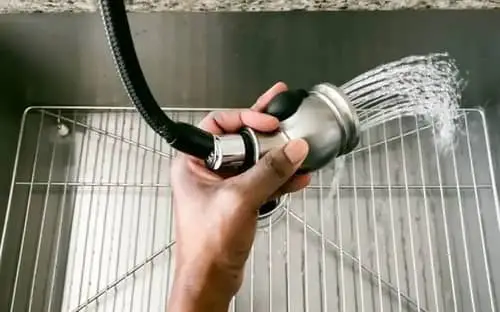
The Sprayer hose is the part of the kitchen sink that does not come in the basic package. But it is a useful addition and helps a lot when you are washing dishes by hand. This part is usually located between the faucet and the water supply within the system. Its integral part is the connecting valve that controls the direction of water injection. Note that a tap is not used for direct water discharge when a sprayer hose is used.
6. Countertop
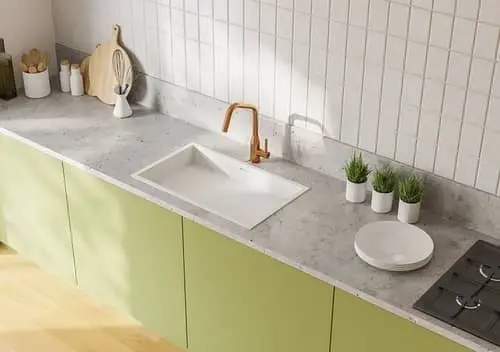
A kitchen countertop is a flat working area that is placed around the sink. It can be made of different materials, and the most common choices are marble and granite.
7. Garbage Disposer
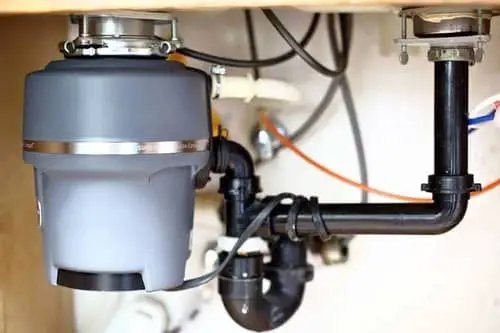
A Garbage disposer is the device that is installed in the position between the drain and the trap. Its main purpose is to grind up the food that ends up in the sink and thus make it easier to pass through the pipes towards the sewer.
8. P Trap
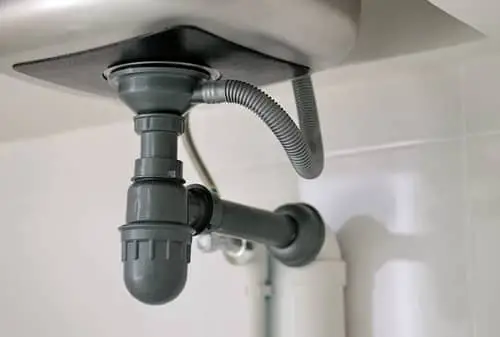
Although the name suggests, the P trap is not actually P-shaped at all! It is a pipe that is more like the letter U. This part has an important function within the kitchen sink system – to prevent water from flowing out of the pipe without control. The main role of the P trap is to stop sewer gas from coming up into the kitchen from the drain.
Residual food and grease can clog up the P trap and cause the water from the drain to return to the sink. This is a problem that urgently needs to be solved by unclogging the P trap. You can try to do this by pouring hot water into the drain. If this does not solve the problem, professional help will be needed.
9. Tailpiece
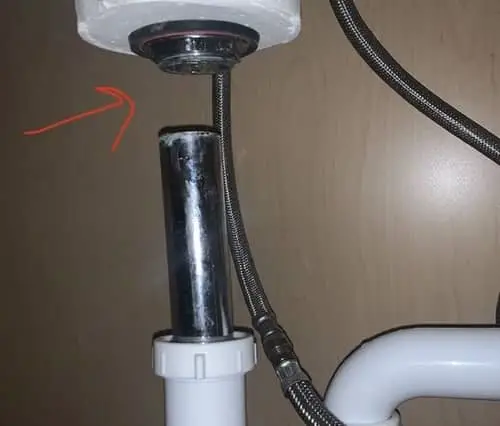
The tailpiece is a flat pipe that is connected to the P trap, and it is located under the strainer basket. Its function is to directly supply water to the plumbing system of the sink.
10. Waste Arm
The Waste arm is the part that continues on the P trap. This pipe is attached to the trap on one side with the help of a washer and a nut, while on the other side it is connected to the main drain. It has the function of draining dirty water from the sink into the sewer.
11. Cold and Hot Water Supply Pipes
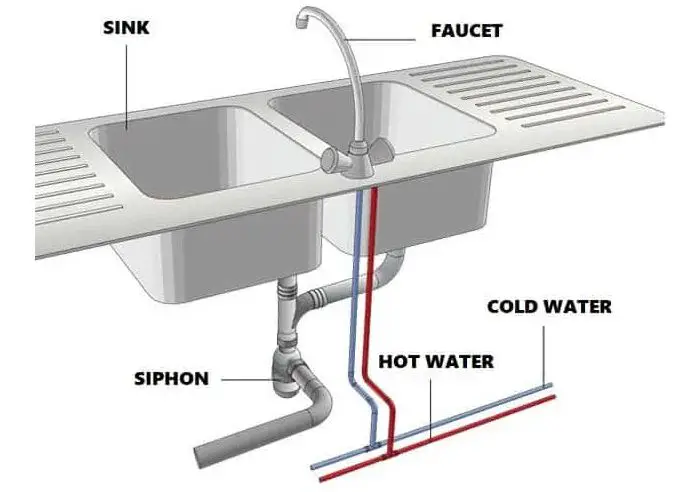
The pipes that supply the sink system with hot and cold water are connected to the faucet and are usually hidden under the sink or under the kitchen stand. They are installed so that hot water comes out of the one placed on the left, and cold water from the one placed on the right. Note, these pipes can extend through the floor of the house.
12. Rubber Gasket
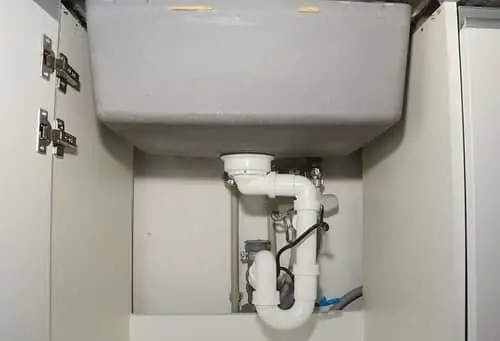
A Rubber gasket has the function of connecting the parts of the sink, and it serves as protection against water leakage between the different joints.
13. Basket Strainer
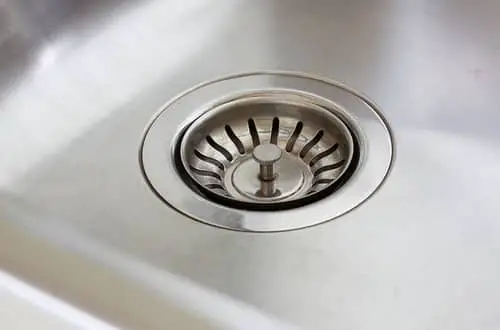
A Basket strainer is a slotted piece that is located at the bottom of the sink and it is used to allow water towards the drain, but to retain debris. Part of this is due to the need to keep food scraps and other larger waste in one place within the sink system so that they do not end up in the pipe. If the basket strainer cannot be installed so that it sits directly on the opening, more putty should be used or a professional should be called.
14. Drain Pipe
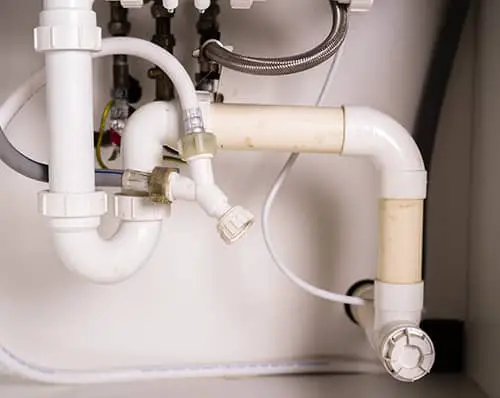
Drain pipe is one of the most important parts of the sink in the kitchen. It is a long pipe that is made of plastic or metal that is located below the sink. It has the task of draining wastewater from the sink into the sewer. Also, this tube helps control the pressure in the pipes to prevent clogging. Today, copper or plastic pipes are most commonly used. Once upon a time, until the middle of the last century, drain pipes were made of iron or steel.
15. Shutoff Valve
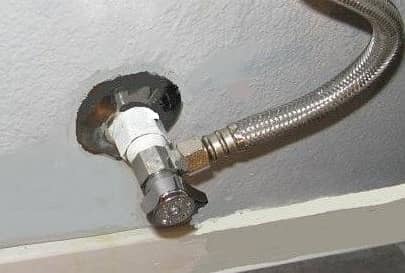
The clean and dirty water that is part of your home system inside the sink does not flow through the same pipes. If these pipes need to be replaced or leaks need to be repaired, it is necessary to stop the flow of clean water into the system by turning the shut-off valve. This is certainly a better option than turning off the whole household from the main water supply!
How to Install a Kitchen Sink? DIY Tips
First, you need to choose and buy the sink you want, and then you can start installing it on the kitchen surface. Note, undermount sinks must be installed under the kitchen counter, which has a solid surface countertop, such as stone. When choosing a sink, this time, you may want to choose a deeper basin sink than the one you had before. Keep in mind that if your new sink hangs down too low, you may have drain problems where you will need to lower the tee connection.
If you want to install a new kitchen sink read and follow these steps:
- Step 1: First you need to carefully measure the sink you want to replace with a new one. If the dimensions of the new sink are different, you may need to make modifications to the plumbing or drainage system. Or you will, in a better case, have to adjust the opening on the kitchen worktop to a new sink. Note, when doing anything under the sink you should always protect your eyes with safety goggles.
- Step 2: Remove the old sink from the kitchen worktop, and before that be sure to note (ideally with a photo), how the sink was connected to the installations so you know how to restore the system to its original state after installing the new sink. Then you need to turn off the water in the kitchen with the help of shut-off valve which is usually located below the sink.
Using a wrench, cut off the water supply to the faucet. Before you do that, prepare an empty bucket in the kitchen that you can use to drain water if it suddenly starts leaking from the drain. - Step 3: Now is the time to install a new sink on your kitchen countertop. If the existing opening is not suitable, adjust it with a router, cutter or try to arrange the parts differently. When the new sink is bigger than the old one, you need to turn it to the other side, mark the necessary measures and then expand the opening with the help of the tools that we have mentioned. Then remove the sink from the hole, fasten the rivets and push it down.
- Step 4: Once you have installed the sink, it is time to connect the faucet and other components. When installing the strainer, use a small amount of jointing compound, spread it over the entire surface of the strainer and then press it firmly into the ground. When it comes to basin edges it is best to use silicone mass.
- Step 5: Now install the water pipes on the faucet and tighten the connections. But don’t over do it!
- Step 6: Reconnect the kitchen sink system to the water pipes, run the water through pipes and check for water leaks inside the system.
FAQ: People Also Ask
What is the drain assembly for a sink?
It is a method of connection based on the P trap kitchen sink. The stopper and a flange are connected to the drain pipe. On the drain pipe continues the rod and ball system that allows the movement of the drain system.
What are the parts of a faucet called?
The main parts of the faucet are: flow restrictors, cartridges, aerators, and stems. In order for the faucet to work in an intended way, the key role is played by: O-ring, washers, flanges, and escutcheons. To adjust the flow of water through the faucet parts are: handles, caps, and index buttons.
What is a sink flange?
The flange of the sink represents the ring that surrounds the drain of the sink. It is mostly made of metal, but it can also have plastic as a base, which is then wrapped with a layer of metal. When rust accumulates on the flange or the flange crack, you can expect water to leak into the sink system.
Final Thoughts
Having learned what are the main parts of a kitchen sink, we believe you now have a basic knowledge of each part’s function. If you are planning to install your kitchen sink by yourself, be sure to understand each part. I hope that this article has helped you and that you will successfully do this task. If you have any questions about the kitchen sink or parts be free to contact us.


